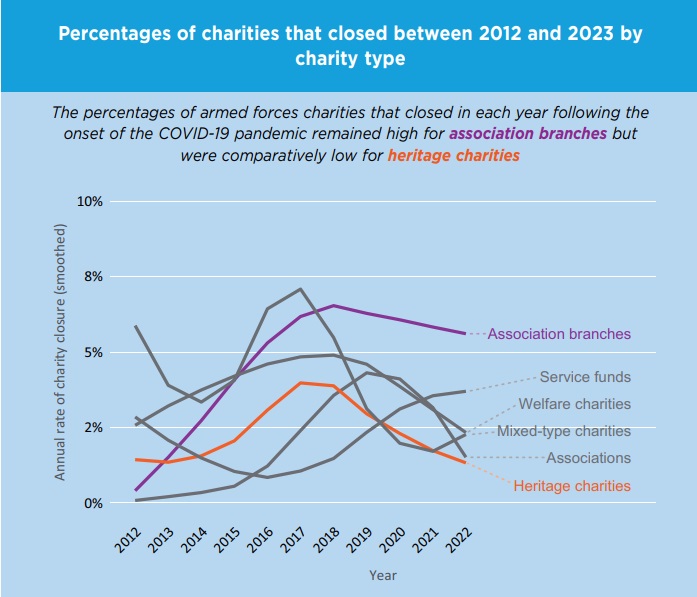The number of armed forces charities in the UK has declined by 10% since 2017, according to new research.
There were 1,917 armed forces charities in 2012, according to a report by Forces in Mind Trust and Directory of Social Change, a number which fluctuated before returning to the same level in 2017.
But the number has decreased each year since 2017, it says. Openings have been less numerous than closures, reaching 1,733 in 2023, making up around 1% of the overall charity sector.
Despite the decline, at the report’s launch yesterday, Legion Scotland chief executive Claire Armstrong said the sector was “saturated” and the issue of duplicated armed forces charities needed to be addressed.
Local branches merging
The report says the recent decline in armed forces charities has been led by local association branches closing or merging with their overarching charities, with 37% fewer association branches in 2023 than in 2012.
There were 22% fewer RAF charities, a similar decline in Royal Navy charities, and a 7.8% reduction in British Army charities.
However, the report noted a 4.6% increase in charities that serve all three sets of beneficiaries.
The report says “there appears to have been no cliff edge in the closure of armed forces charities” since the Covid-19 pandemic began, with the annual rate of closure being 3.4% in 2020, 3.9% in 2021 and 3.2% in 2022 – all lower than in the preceding three years.
Meanwhile, the armed forces charity sector’s income fell by 23% from £1.06bn in 2019 to £820m in 2020, the report says, while expenditure decreased by 8% from £1bn in 2019 to £920m in 2020.

‘Saturated’ sector
Asked whether there were still too many armed forces charities at the report’s launch yesterday, Legion Scotland chief executive Claire Armstrong said the sector was “saturated”.
“It’s a complicated landscape for sure and I think it’s very saturated, especially in some areas,” she said.
Armstrong said the issue of duplication of armed forces charities had come up frequently in recent years.
“We constantly see additional and numerous smaller charities as you refer to popping up and they’re well-meaning and have a fantastic idea and want to take the work forward.
“But there’s not enough […] looking at what already exists and […] people asking themselves the question: can we work with those who are already set up and enhance that service, rather than trying to set up yet another new organisation?
“So yeah, it’s a saturated sector without a doubt but everyone is so passionate about individually what they’re doing.
“So, it makes the question very, very difficult to ask, who gets to stay and who may have to go, but it’s coming around over and over again and I think it’s something that’s going to have to be addressed.”
Related Articles












